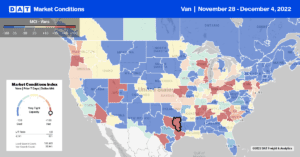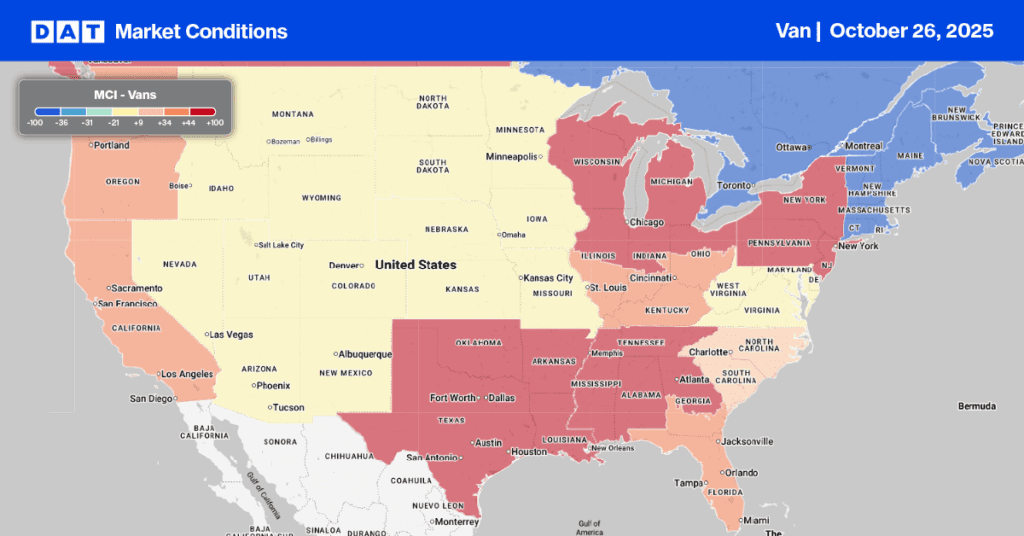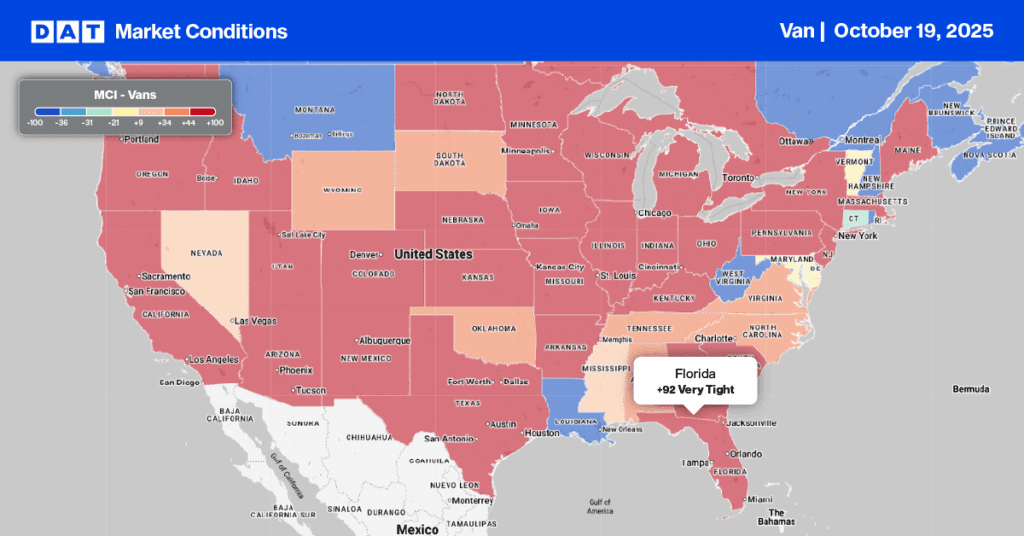Truckload demand may well be cooling unseasonably in the fourth quarter, but according to the American Trucking Associations’ For-Hire Truck Tonnage Index, truck tonnage increased by 2.8% in October compared to the previous year. This was the fourteenth straight year-over-year gain, although tonnage decreased sequentially by 2.3% in October after rising 0.8% in September. The ATA tonnage index is based on surveys from its membership and is dominated by contract freight.
According to ATA Chief Economist Bob Costello, “For-hire truck tonnage saw the largest single monthly decrease in October since the start of the pandemic. The decrease fits with the anecdotal reports of a muted fall freight season. It also coincides with a slowing economy. Housing is a weak spot in freight in addition to a slowing in personal consumption of goods. While factory-related freight is holding up better than other areas, it is also decelerating.”
Market Watch
All rates cited below exclude fuel surcharges unless otherwise noted.
Even though the rail strike threat was averted last week, it didn’t stop shippers from taking preventive measures and diverting some volume to truckload. DHL Global Forwarding told CNBC the previous week that companies supplying critical semiconductor chips to the economy shifted cargo shipments from railroads to truckload, loads crucial in the high-tech sector and auto industry. The Top 10 intermodal ramp markets, which accounted for a quarter of truckload spot market load posts last week, saw a 92% w/w in volume. The effect on available capacity was a $0.05/mile increase in outbound spot rates to $1.88/mile, which is $0.08/mile higher than the national average.
According to DHL, the increase in the volume of loads moving out of Los Angeles by road was driven by technology-related imports. According to IHS Markit, 92% of containerized semiconductor chip imports originated in North and South East Asia in October, with 41% landing in Long Beach and Los Angeles ports. The number one exporter of semiconductor chips to the U.S. was China (27%), followed by Vietnam (21%), and Hong Kong and Korea (both 10%).
On the high-volume intermodal lane between Los Angeles and Chicago, the volume of loads moving by truck increased by 38% w/w after decreasing for the three weeks prior. Shippers and Brokers found plenty of available capacity, with a corresponding surge in spot rates not materializing. Spot rates on this lane did, however, increase slightly to $1.42/mile, while overall outbound Los Angeles spot rates for all lanes decreased $0.02/mile to $1.75/mile. In Chicago, outbound spot rates for loads to Memphis jumped almost $0.40/mile last week to $2.39/mile, and on the Atlanta lane, spot rates increased by $0.13/mile w/w to $2.42/mile.

Load-to-Truck Ratio (LTR)
The week after Thanksgiving is always catchup following the prior short workweek. Load posts surged, increasing by 160% w/w, and are back to over one million weekly load posts for the first time in two months. The threat of rail strike sent some intermodal volumes to the truckload spot market – in the Top 10 intermodal ramp markets, volumes were up 92% w/w. Carriers returned to the market after the holiday break, and even though equipment posts were still at the highest level in six years, volumes dropped by 16% compared to the week before Thanksgiving indicating available spot market capacity tightened on higher load volumes. As a result, last week’s dry van load-to-truck ratio (LTR) more than doubled, increasing from 2.13 to 4.49.
Linehaul Spot Rates
Following the short workweek and carriers taking time off over the Thanksgiving break, a surge in spot market volumes resulted in available capacity tightening for the second week following last week’s $0.03/mile gain. The national average dry van rate, at $1.80/mile, has decreased by 35% since the start of the year and is now $0.75/mile lower than the previous year and identical to 2018 levels. The national average linehaul rate of $1.80/mile is $0.30/mile lower than the top 50 dry van lanes based on the volume of loads moved, which averaged $2.10/mile last week.


